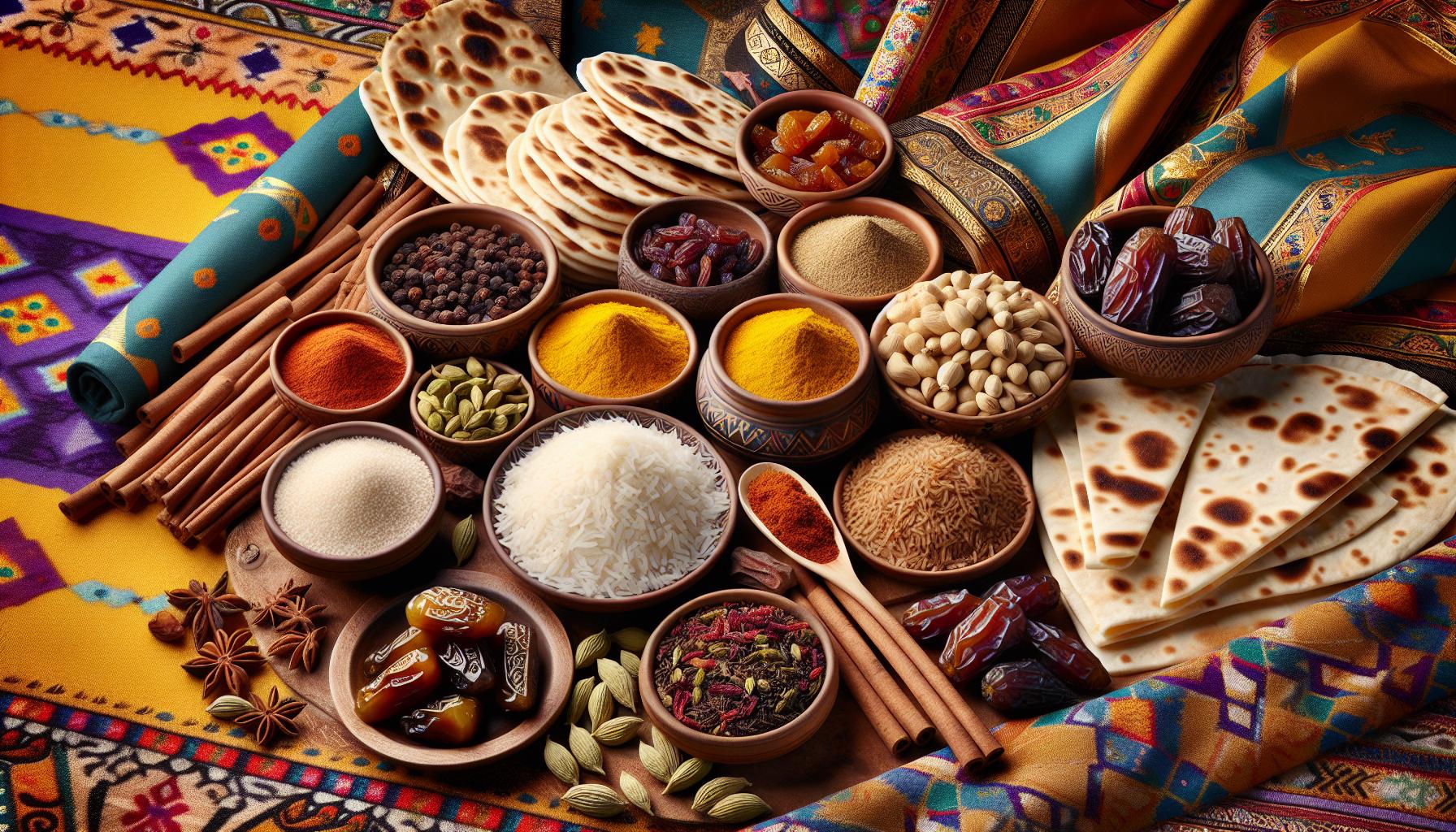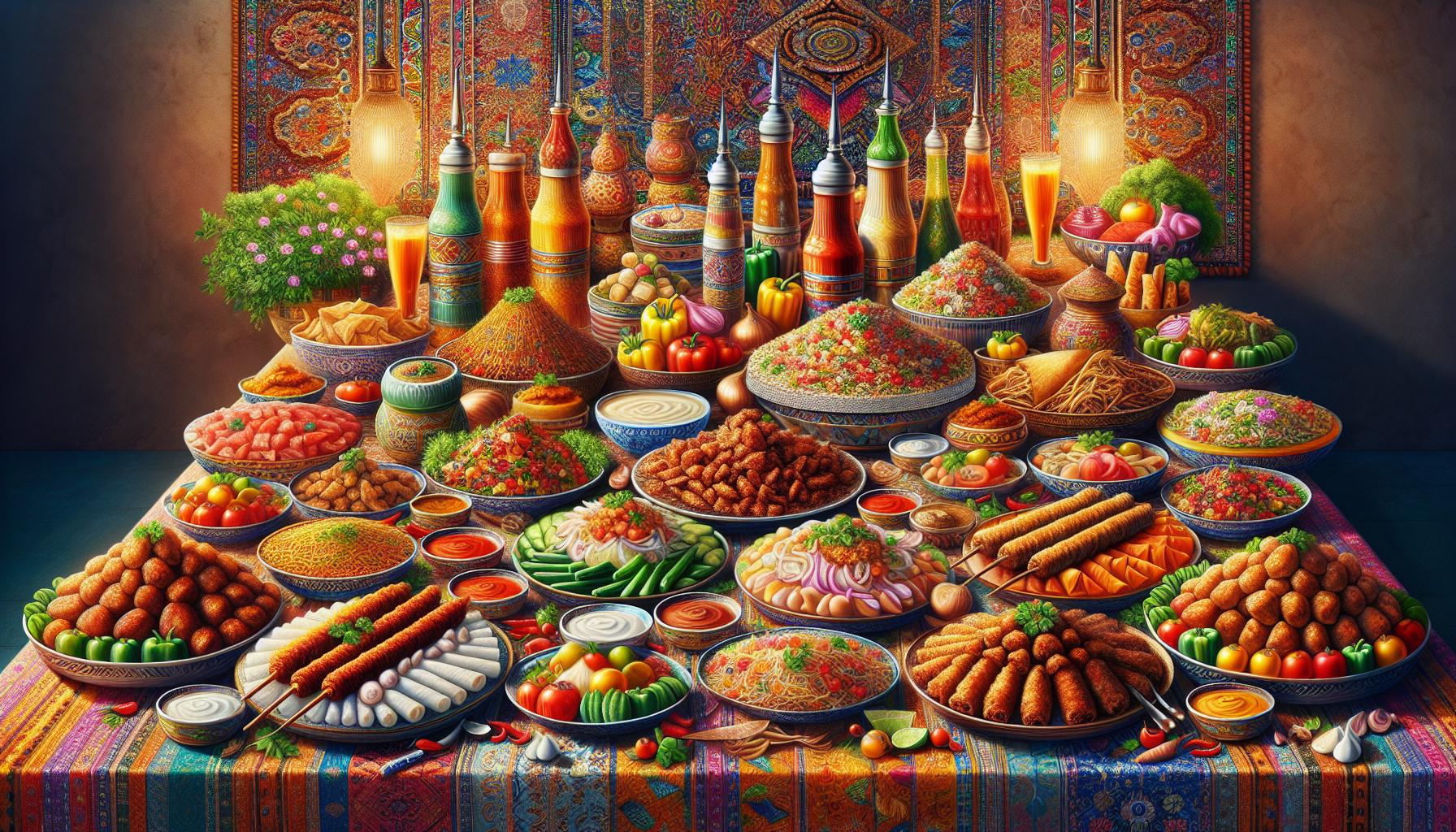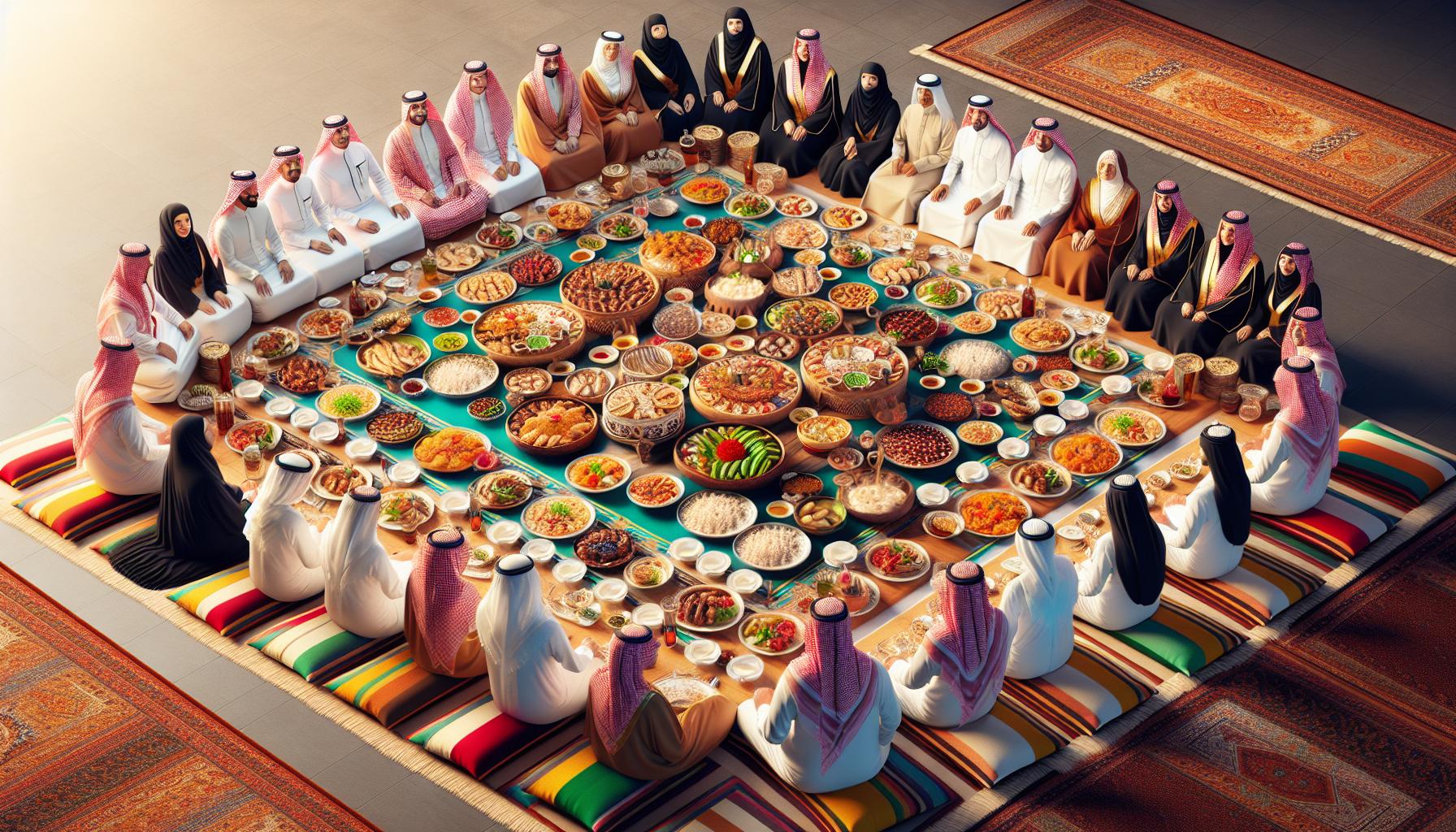Saudi Arabian cuisine stands as a testament to centuries of cultural heritage, blending Bedouin traditions with modern Middle Eastern flavors. From aromatic rice dishes to succulent grilled meats, the kingdom’s food culture reflects its rich history and deep-rooted hospitality customs.
Dining in Saudi Arabia isn’t just about eating – it’s an experience that brings people together. Whether it’s sharing a communal plate of Kabsa (the national dish) or sipping traditional Arabic coffee with dates, food plays a central role in social gatherings and celebrations. The traditional practice of eating with the right hand while seated on floor cushions still persists, though modern restaurants now offer contemporary dining settings.
Saudi Arabia Food Culture
Saudi Arabian cuisine combines centuries-old Bedouin cooking methods with influences from surrounding Middle Eastern cultures. The traditional cooking techniques reflect both nomadic lifestyles and Islamic cultural heritage.
Influence of Islamic Dietary Laws
Islamic dietary laws shape Saudi Arabian cuisine through specific preparation requirements and ingredient restrictions. All meat must be halal, meaning animals are slaughtered according to Islamic law. Pork products remain strictly forbidden under Islamic law, while alcohol faces complete prohibition in food preparation. Common meat options include lamb, chicken, beef and camel – each prepared through specific halal methods. Seafood preparation follows Islamic guidelines that ensure freshness and proper handling. Food storage practices align with Islamic principles of cleanliness and preservation.
Regional Food Variations
The diverse regions of Saudi Arabia feature distinct culinary traditions based on local ingredients and historical influences. The Hijaz region incorporates Turkish and Levantine flavors into dishes like Mandi and Magliya. Eastern Province cuisine displays Persian Gulf influences through seafood dishes and rice preparations. Northern regions feature hearty meat dishes with Jordanian and Iraqi elements. The central Najd region maintains traditional Bedouin recipes like Jareesh and Margoog. Southern provinces utilize unique spice blends reflecting Yemeni culinary traditions. Coastal areas emphasize fish dishes with Red Sea or Persian Gulf influences.
Essential Ingredients in Saudi Arabian Cooking

Saudi Arabian cuisine relies on a specific set of ingredients that form the foundation of traditional dishes. These essential components reflect the region’s cultural heritage and agricultural capabilities.
Aromatic Spices and Herbs
Saudi Arabian cooking incorporates a diverse array of aromatic spices that create distinctive flavor profiles. Cardamom pods infuse rice dishes with a sweet aromatic essence, while saffron adds golden color and floral notes. Coriander seeds, cumin, turmeric, black pepper, cinnamon bark, cloves contribute depth to meat marinades and stews. Fresh herbs like parsley, mint, cilantro (coriander leaves), green onions enhance both cooked dishes and salads. Traditional Saudi spice blends combine multiple aromatics, such as baharat (a seven-spice mixture) and bezar (a Gulf-style seasoning blend).
Staple Foods and Grains
Rice forms the cornerstone of Saudi Arabian cuisine, particularly long-grain varieties used in signature dishes like Kabsa. Wheat flour produces traditional flatbreads including khobz, tamees, roti. Dates serve as both a dietary staple and cultural symbol, eaten fresh or dried throughout the day. Legumes such as lentils, chickpeas, fava beans appear in soups, stews, dips. Grains like bulgur wheat, semolina, pearl barley create hearty side dishes and provide essential nutrition. Local dairy products incorporate fresh yogurt, dried yogurt (jameed), ghee (clarified butter).
Popular Saudi Arabian Dishes

Saudi Arabian cuisine features distinct regional specialties that showcase the country’s culinary heritage through aromatic spices, tender meats, and flavorful rice preparations.
Traditional Rice-Based Meals
Kabsa stands as Saudi Arabia’s national dish, combining aromatic rice with tender meat cooked in a blend of spices including cardamom, saffron, cinnamon, black lime, bay leaves, and nutmeg. Roz Bukhari brings Persian influence to Saudi tables with its fragrant basmati rice mixed with spiced chicken, carrots, raisins, and nuts. Mandi employs a unique underground cooking method that produces smoky rice topped with lamb or chicken. Saleeg presents a creamy rice porridge from the Hijaz region, cooked in milk and served with chicken. These rice dishes incorporate local ingredients such as dates, nuts, and dried fruits to create layers of texture and flavor.
Meat Specialties and Kebabs
Saudi Arabian meat dishes reflect centuries-old cooking traditions with lamb and chicken as primary proteins. Shawarma presents thinly sliced meat stacked on vertical spits, served in bread with tahini sauce and vegetables. Mutabbaq features stuffed flatbread filled with minced meat, eggs, and vegetables. Jareesh transforms cracked wheat and meat into a hearty dish topped with ghee and onions. Thareed combines tender lamb with vegetables in a rich broth, served over torn pieces of flatbread. Traditional kebabs include Lahm mashwy (grilled lamb) and Shish tawook (marinated chicken cubes) seasoned with Middle Eastern spices.
Saudi Arabian Dining Customs and Etiquette

Saudi Arabian dining customs reflect deep-rooted cultural values centered around hospitality, respect and family bonds. Traditional dining practices emphasize communal eating and specific etiquette rules that honor Islamic principles.
Family-Style Dining Traditions
Saudi meals exemplify community spirit through shared platters placed in the center of the dining area. Families gather around a traditional floor mat called sufrah for main meals, particularly lunch which serves as the day’s principal meal. Large communal plates accommodate multiple diners, with separate dining areas often designated for men and women in accordance with cultural norms. Hosts demonstrate generosity by continuously offering additional servings throughout the meal, while guests show appreciation by accepting these offerings. Traditional homes maintain dedicated majlis (sitting rooms) for hosting meals with extended family or guests.
Traditional Table Manners
Saudi dining etiquette follows specific cultural protocols that maintain respect and cleanliness. Diners eat exclusively with their right hand, using the thumb and first two fingers to gather food. Guests wait for the eldest person or host to begin eating before starting their meal. Speaking during meals remains minimal, focusing instead on the act of eating. When finishing a meal, diners leave a small portion of food on their plates to demonstrate satisfaction. Proper etiquette includes saying “Bismillah” (in the name of God) before eating and “Alhamdulillah” (praise be to God) after completing the meal. Guests express gratitude by offering specific phrases like “Sahtain” (double health) to their hosts.
Festivals and Food Celebrations
Saudi Arabian festivals center around religious observances with distinctive culinary customs that bring families together. These celebrations feature traditional dishes prepared with special ingredients during specific times of the year.
Ramadan Food Traditions
Iftar marks the daily breaking of the fast during Ramadan with dates accompanied by Arabic coffee or water. Saudi families prepare elaborate evening meals featuring Sambousek (meat-filled pastries) Harees (wheat porridge with meat) Thareed (bread soaked in meat broth) for the main course. Pre-dawn meals called Suhoor include lighter dishes like Foul (fava beans) Shakshuka (eggs in tomato sauce) Labneh (strained yogurt). The month features signature Ramadan beverages including Qamar Al-Din (apricot juice) Jallab (dates syrup with pine nuts) Tamar Hindi (tamarind drink).
Eid Culinary Customs
Eid Al-Fitr celebrations begin with sweet dishes like Ma’amoul (date-filled cookies) Kleeja (cardamom cookies) Luqaimat (sweet dumplings). Traditional breakfast tables display Sharia (sweet vermicelli) Balah El Sham (Middle Eastern churros) fresh fruits. The main Eid feast features Ouzi (whole roasted lamb with spiced rice) Kabsa (rice with meat) Jareesh (cracked wheat with meat). Extended families gather for multiple days sharing special dishes like Qursan (bread with meat curry) Margoog (vegetables with meat in thin dough). Hosts serve Arabic coffee with dates throughout the celebrations.
Modern Influences on Saudi Food Culture
Saudi Arabia’s culinary landscape has evolved significantly through globalization international trade networks. Modern influences shape both traditional recipes modern dining experiences while maintaining cultural authenticity.
International Cuisine Impact
International restaurants populate Saudi cities offering diverse global flavors from Italian pizzerias Japanese sushi bars. Global franchises like McDonald’s Starbucks operate alongside local establishments creating fusion dishes that blend Saudi traditions with international elements. The younger generation embraces diverse cuisines particularly Asian European influences incorporating new ingredients cooking techniques into traditional Saudi dishes. Popular fusion creations include shawarma burritos za’atar crusted pizzas demonstrating cultural culinary integration.
Contemporary Dining Trends
Food delivery apps transform dining habits enabling convenient access to diverse cuisines. Social media platforms inspire Saudi chefs to experiment with presentation plating techniques creating Instagram-worthy dishes. Fast-casual dining concepts gain popularity offering traditional Saudi dishes in modern quick-service formats. Health-conscious eating trends lead to modifications of classic recipes with reduced oil lighter cooking methods plant-based alternatives. Food halls food trucks emerge in urban areas providing casual dining spaces that combine traditional Saudi fare with international options.
Unique Culinary Heritage
Saudi Arabian food culture stands as a vibrant testament to the nation’s heritage blending centuries-old traditions with modern influences. This rich culinary landscape reflects deep-rooted values of hospitality generosity and family bonds through its distinctive dishes dining customs and celebratory feasts.
While traditional elements like communal dining Kabsa and Arabic coffee remain central to Saudi food culture the cuisine continues to evolve. Modern Saudi Arabia embraces both its cherished culinary heritage and contemporary global influences creating a dynamic food scene that bridges past and present.
The fusion of time-honored recipes with innovative cooking techniques and international flavors showcases how Saudi Arabian cuisine adapts while maintaining its cultural identity. This delicate balance ensures that future generations will continue to savor and celebrate their unique culinary heritage.

